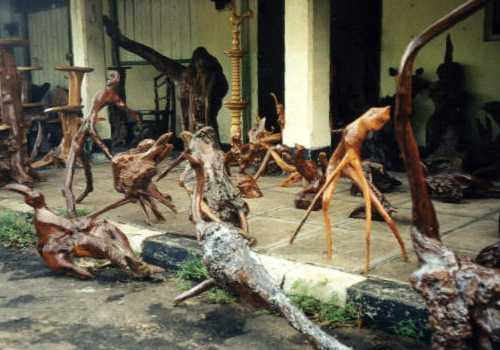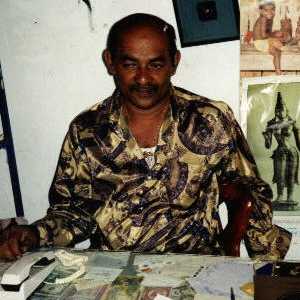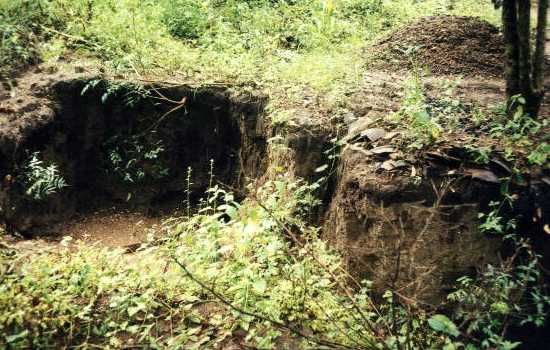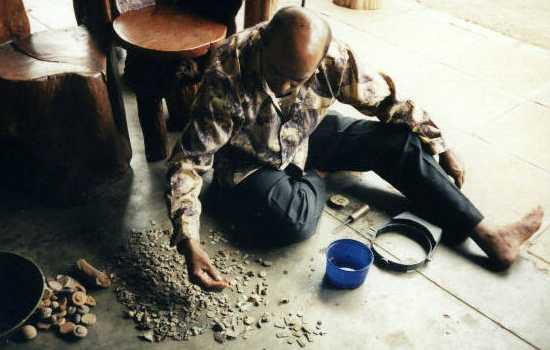
The villagers saw value in mainly the gems they found. Any gold or silver coins were sold to the local jewelry trade and most often melted unless spotted by someone who recognized its numismatic value. Rare copper and lead coins and pottery of various size and shape were discarded as valueless. A local trader Mr A. Ratnayake who moved into the area in the late 1980's started collecting the discarded items and found a market for them in the Chatham street Coin shops in Colombo and also at similar shops in Galle. Those dealers saw the value in the ancient items but gave little to get them from the local collector. After a chance meeting in Galle of Mr Ratnayake with Rajah Wickremesinhe from Colombo these items got directly to the hands of a knowledgeable collector. Getting more compensation for the items the local collector expanded his search for items and encouraged the villagers to dig and look for them. It also stopped the discarding of the copper and lead coins as well as the Pottery, beads and other miscellaneous items of archaeological interest.
I met Rajah Wickremesinhe in 1999 and 2000 in Colombo and was able to obtain from him a number of coins from Ruhuna, some of which had been published by him in his detailed monograph Ruhuna. An Ancient Civilization Re-visited on the subject with Prof Osmund Bopearachchi. I also met Brig. Munesinghe, current president of the Sri Lanka Numismatic Society (SLNS), who had also obtained a significant collection of punch mark and Lakshmi plaque coins from Mr Ratnayake in Katharagama. Although much had been written about the coin finds from Akurugoda, I had been able to find out very little about the place itself. On my last visit to Lanka in late 2001, I decided to visit Ruhuna to see and photograph for myself the excavations where all these ancient coins were being found.
| Akurugoda near Tissamaharama, is close to Katharagama (a major place of religious worship) and about 165 miles south-east of Colombo. It takes about 6 to 7-hours of travel by road to get there. After debating if to hire a car and driver for the trip for about US$115, I decided to catch an Air-Conditioned bus (cost < US$2) from the main Colombo Bus stand in Pettah early in the morning of 2001 December 17th. Unable to find a direct bus leaving at 6 AM, I took a bus to Matara, and then to Hambantota, and finally a local bus to Katharagama reaching the "GamUdawa" junction at about 12:45PM, where I had been asked to get down by the local collector. | 
|
| The Junction is marked by the Clock Tower built by Premadasa in 1987 for one of his annual "GamUdawa" (Village reawakening) celebrations. The clock still chimed the hour on time but the clock face was a few hours in error because of frequent power-cuts. Mr Ratnayake has a large tourist shop selling wood carvings and arborics. | 
|
| I met the collector in his shop and soon he was showing me lots of interesting items from his collection of ancient items found in the region. There were large stocks of pottery items of different shape like Seals, disks, ellipsoids, balls, beads, each of a wide range of sizes; and also metallic items rings, pendents antimony rods etc The full range of items as cataloged in Rajah Wickremesinhe's book. He told me that most of the items in that book had been supplied by him. I felt that he was disappointed that his major contribution to that publication had not been properly acknowledged. I picked out a representative sample of items for the LakdivaCoin collection. | 
|
Although trading with items of significant value, Mr Ratnayake lived in a humble abode. After sharing a simple meal, we left later in the afternoon in a 4-wheel drive vehicle to visit some of the local farmers near Tissamaharama who supplied him with their archaeological finds. He needed to do this trip regularly or else loose any interesting finds to dealers who have now started to pick the trail. Having been one of the first collectors to pay cash for what was considered worthless, he commanded some respect and loyalty, but the villagers in need of funds could not wait too long and sold most often to the first good offer they got.
| The farmers dig the ground in their plot of land when they had no tasks for cultivation. It keeps them occupied at times of drought and they hope to find something of value to earn a few extra rupees to feed their hungry families. They dig only to a depth of about 4 feet since experience has showed them, that below that depth hardly any items of interest are found. Their main interest is to find gems. Everything else that remains in the basket after the mud has been washed away is a bonus. They don't keep proper records of the depth at which the items were found and their recollection when asked is probably biased by what they think you would like to hear. The coins ranged from silver punch-marks and Lakshmi plaques used in the Ruhuna Kingdom two thousand years ago from the lowest layers to more modern 17-18th century Dutch period coins and even a few Victorian coins from the mid-19th century in layers close to the surface. The farmers collect all their finds in a bag and if they feel there are items of particular value, they would even bury the bag rather than just hide it under their bed. Dealers who visit them will pick out what they find interesting and the rest remains and grows with any new find. | 
|

|
It is unfortunate that the farmers still did an uneducated quick check to see if the coins were of silver or Gold. However I found that even Mr Ratnayake, after all his interactions with Numismatists was totally ignorant of even basics of cleaning coins.
|
It is amazing that even few survive the abuse they are put
through. Some of the crude methods of cleaning he described are:
| 
|
Some ancient coins that have been abused in this way, particularly those that have been fried appear to look like fakes. Those cleaned with an chisel have scrape marks which clearly look modern. Although sad about abuse I have gained more confidence on this trip that these coins are genuine.
I was lucky to obtain some uncleaned specimens, just as they are found in the wash. Both the farmers and local collectors need to be educated that they need should preserve the coins as found without making any crude attempt to clean them. They should at most wash them in water and dry them which anyway occurs in the discovery process. They need to understand that they depreciate the numismatic value of the coins significantly and in many cases destroy them by the crude methods they employ to clean the coins.
At the first farmers house, he brought out a bag of a wide variety of objects that had been found in recent excavations. There were some very interesting items.
| A disk made of a black polished Pottery with an Elephant and Srivatsa symbols on either side, a nice ring- mould, and a Lankan curiosity - a small metal spoon to clean ear wax (age unknown). The items clearly were of significant value and I was unsure how much to offer and almost felt they maybe outside my range. The farmer said a price for the 3-items which I would have expected to pay in Colombo. The collector offered a fraction of that requested and the deal was closed, with the farmer acknowledging that the collector was the authority and he could not refuse his offer. I found myself buying items well below their worth as was pointed out to me when we returned to the vehicle to travel to the next place. | 
|
We visited a number of other farmers. Some had interesting items, some had nothing significant to offer. I understood the nature of the trade. These farmers saw the collector as a source of supplementary income. He ensured that at each visit he purchased something. If they didn't have any item of archaeological interest, the collector would at least buy some produce from their land. He might pay more than the value of the goods purchased on one visit, and buy items at a bargain on another. It was almost a payment for digging. When the collector was interested in excavating a particular region, he would finance their fuel cost to work the water pumps to wash the soil. It was a truly co-operative arrangement which seemed to benefit all.
|
We also visited the site of the official government
excavation in
collaboration with a German Team. Marked by a tall stone pillar with
Brahmi script which had been re-erected by Premadasa at the center of
the site. The region immediately surrounding this pillar had been
archaeologically excavated to a depth of 12-feet. The number of coins
found in this region with proper layer information is important to try
and date the larger number of similar items found by the farmers on
their land.
That night I stayed at a clean but inexpensive tourist lodge catering mainly to visitors to Katharagama. The Air-conditioned room cost under US$20 for night including 2-meals. Malaria is a reality in this part of the country and it is essential to take the required preventive medication before and after a visit and reduce the chance of exposure to mosquitoes as far as possible. | 
|
| The next day we traveled about 40 miles north to Maligawila just outside the northern boundary of the Yala wildlife sanctuary, a region with remarkable ruins of Ruhuna. There were many Dagoba's, Ruins of Monasteries and Palaces, great statues like the 34 foot standing Buddha which had been restored from decay by Premadasa. Despite contradictory accusations, Talking to the villagers one realizes the great influence the Late President Premadasa has had on the people of this region who had felt a great improvement in their standard of living during his time. | 
|
| We visited a few farmers. Looked through their bags of ancient goodies. We were shown a small coin pot which had been discovered without any coins. All the villagers who had been given this state land seem to be finding small quantities of ancient items including coins in any place they excavate. The full region clearly needs to be declared, protected as any other important archaeological site. Major archaeological discoveries are still found accidentally in home gardens of villagers and probably only a few are properly reported and excavated by the archaeological Department. We visited one such site which had been marked out after the base of a large buddha statute had been detected a few feet underground. | 
|
That evening at 9 PM, with a small parcel of ancient items and coins, I caught an air-conditioned coach from Katharagama directly back to Colombo, and was lucky to get off at about 4 AM, within walking distance of home. I met Mr Ratnayake again in Colombo on December 29th at a handicraft sale and obtain a few more interesting items he had sent to Colombo for exhibition and sale at the SLNS 25th anniversary. The Internet allows one to exhibit Lankan heritage to the world without exporting the items. It was a long time before I had the time to research and write web pages for over 40 interesting items from the ancient Kingdom of Ruhuna that I have acquired on this recent trip to Lanka. I however wrote up these impressions from this very educational trip while they were still fresh in my mind.
An edited version of this article Where farmers till for coins By Kavan Ratnatunga appeared in the SundayTioms of Sri Lanka on 2002 March 24th.